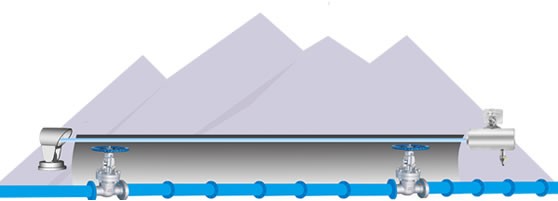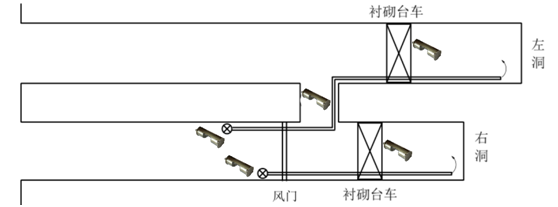
ABOUT
Hanhai Opto-electronic is a major scientific research achievement transformation institution of the Hefei Institute of Physical Science, Chinese Academy of Sciences.
Background overview
Tunnel is a very common form of passage in the process of railway construction. In excavation construction and daily operations, there are a variety of dangerous gas threats, such as methane, hydrogen sulfide, sulfur dioxide, carbon monoxide, etc. These dangerous gases need to be monitored at all times to ensure that they are below a safe concentration.
Due to technical limitations, traditional monitoring equipment has many problems, such as low measurement accuracy, poor alarm timeliness, high false alarm rate, small coverage, high maintenance costs, and susceptibility to electromagnetic interference. In addition, the oxygen content in plateau areas is low, and the normal operation of traditional chemical reaction sensors will be affected.
Laser absorption spectroscopy technology is currently the most advanced gas detection technology. Its working principle is that each gas molecule has a unique absorption spectrum under a specific wavelength of laser light, which enables qualitative and quantitative monitoring of hazardous gases. This technology can make up for many shortcomings of traditional monitoring equipment. It uses laser as its working principle and does not require oxygen for chemical reactions. It can be used for normal monitoring in high altitude hypoxic environments; it can achieve large-scale, regional, active, and high-sensitivity monitoring. Electromagnetic interference; to achieve specific monitoring points without power supply to ensure intrinsic safety; to achieve essential improvements to existing technologies in terms of monitoring accuracy, response speed, operation and maintenance costs, ease of use, and ultra-long service life; to achieve maintenance-free monitoring equipment, No need for calibration, simple operation and other advantages, overall cost reduction, and economic performance improved.
(1) Monitoring of dangerous gases in the main part of the tunnel
During the excavation, construction and operation of the tunnel, the mountains and stratum are likely to contain high concentrations of methane gas and a small amount of hydrogen sulfide. It is necessary to ensure that the concentration of these gases in the tunnel is at a safe level. In the main part of the tunnel, a fixed reflection laser telemeter can be used for monitoring, which is composed of a transmitting end and a reflecting end. The equipment forms a monitoring optical path by emitting laser light, and the space it passes through is the monitored area, and the maximum distance can reach 1km.

Fixed reflection laser telemeter

(2) Dangerous gas monitoring at the tunnel face
Install a fixed scanning laser gas telemeter near the tunnel face (the installation position is based on the actual situation on site, and does not affect the blasting and excavation work), and conduct full-coverage continuous scanning monitoring of the entire tunnel face. The device uses a radar-like rotating scan to form a 360° omni-directional monitoring. The scan radius can reach 300m. At the same time, combined with on-site real-time video monitoring, it can achieve continuous scanning and monitoring of the entire face or blasting surface. Stopping points can be set during the monitoring process to monitor key construction sites or blast holes, and at the same time locate the locations where the gas concentration exceeds the standard.


(3) Hazardous gas monitoring in local non-open areas
Passive optical fiber laser leakage monitoring system can be used in the area near the tunnel's cross passage, return airway, and local ventilators where the space is not open enough. The system is composed of a host and a light-sensing terminal. The host is responsible for emitting the detection laser and receiving the spectrum information returned by the light-sensing terminal. The light-sensing terminal is responsible for collecting the gas concentration spectrum information at the monitoring site and does not need power supply. It is connected to the host through an optical fiber.


The system host is placed in the monitoring center computer room or substation in the tunnel entrance, powered by an external power source, and connected to the light sensing terminal by optical fiber. The optical fiber transmission distance can reach 20km to ensure that the light sensing terminal can go deep into the tunnel. The light sensing terminal is hoisted below the vault, and the host transmits real-time monitoring data to the monitoring platform or remote control center on the computer via the network.

Examples of gas type monitoring solutions
(1) Methane gas
Methane is the main component of methane gas. Because of its own specific gravity characteristics, it will diffuse to the upper part of the tunnel. Therefore, a fixed reflection laser telemeter can be installed on the lower part of the top wall of the tunnel to form a detection light path on the top of the tunnel.
The transmitting end of the device is responsible for laser emission and communication, and the power supply and communication lines only need to be connected to the transmitting end. The reflector is a pure optical device, which can be moved at will without restriction. When the excavation starts, the launching end is installed at the entrance of the tunnel, and the reflecting end is installed at the excavation surface, forming a monitoring range from the tunnel entrance to the excavation surface. As the tunneling deepens, the reflecting end moves inward and gradually expands the monitoring range. When the tunneling depth exceeds 1000m, the second equipment will be arranged.

(2) Hydrogen sulfide
The hydrogen sulfide gas has a higher specific gravity than air and will diffuse below the tunnel when the concentration exceeds the limit. Therefore, a fixed reflection laser gas telemeter can be installed on the lower part of the side wall of the tunnel to form a detection light path at the bottom of the tunnel.

(3) Other dangerous gases
In addition to gas and hydrogen sulfide in the daily operation of the tunnel, there are toxic and harmful gases such as sulfur dioxide and carbon monoxide. For these toxic and harmful gases with a specific gravity greater than or equal to air, they will diffuse toward the bottom of the tunnel when the concentration exceeds the limit. Therefore, a fixed reflection laser gas telemeter can be installed on the lower part of the two walls of the tunnel to form a light path on each side of the tunnel. The maximum monitoring range of the equipment is 1km. If the tunnel length exceeds 1km or there are bends, multiple devices can be combined.

TEL:400-055-1239 (9:00~17:00)
MAIL:lisghanhai@gkhhlaser.com
ADDR:302 Floor, Building 5, No. 18, Kechuang 13th Street, Beijing Economic and Technological Development Zone
